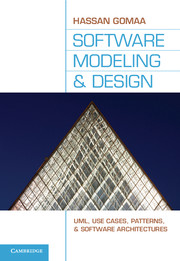Book contents
- Frontmatter
- Contents
- Preface
- Annotated Table of Contents
- Acknowledgments
- PART I Overview
- PART II Software Modeling
- 6 Use Case Modeling
- 7 Static Modeling
- 8 Object and Class Structuring
- 9 Dynamic Interaction Modeling
- 10 Finite State Machines
- 11 State-Dependent Dynamic Interaction Modeling
- PART III Architectural Design
- PART IV Case Studies
- Appendix A Catalog of Software Architectural Patterns
- Appendix B Teaching Considerations
- Glossary
- Answers to Exercises
- Bibliography
- Index
7 - Static Modeling
from PART II - Software Modeling
Published online by Cambridge University Press: 05 June 2012
- Frontmatter
- Contents
- Preface
- Annotated Table of Contents
- Acknowledgments
- PART I Overview
- PART II Software Modeling
- 6 Use Case Modeling
- 7 Static Modeling
- 8 Object and Class Structuring
- 9 Dynamic Interaction Modeling
- 10 Finite State Machines
- 11 State-Dependent Dynamic Interaction Modeling
- PART III Architectural Design
- PART IV Case Studies
- Appendix A Catalog of Software Architectural Patterns
- Appendix B Teaching Considerations
- Glossary
- Answers to Exercises
- Bibliography
- Index
Summary
The static model addresses the static structural view of a problem, which does not vary with time. A static model describes the static structure of the system being modeled, which is considered less likely to change than the functions of the system. In particular, a static model defines the classes in the system, the attributes of the classes, the relationships between classes, and the operations of each class. In this chapter, static modeling refers to the modeling process and the UML class diagram notation is used to depict the static model.
The concepts of objects, classes, and class attributes are described in Chapter 4. This chapter describes the relationships between classes. Three types of relationships are described: associations, whole/part (composition and aggregation) relationships, and generalization/specialization (inheritance) relationships. In addition, this chapter addresses special considerations in static modeling of the problem domain, including static modeling of the total system context and software system context, as well as static modeling of entity classes. Design of class operations is deferred to the design phase, and is addressed during class design, as described in Chapter 14.
Static models are depicted on class diagrams, as described in this chapter. Section 7.1 describes the different kinds of associations between classes. Section 7.2 describes whole/part relationships, particularly composition and aggregation hierarchies. Section 7.3 describes generalization/specialization hierarchies. Section 7.4 provides an overview of constraints. Section 7.5 describes static modeling with UML, in which the initial emphasis is on modeling the physical classes and entity classes.
Information
- Type
- Chapter
- Information
- Software Modeling and DesignUML, Use Cases, Patterns, and Software Architectures, pp. 94 - 114Publisher: Cambridge University PressPrint publication year: 2011
Accessibility standard: Unknown
Why this information is here
This section outlines the accessibility features of this content - including support for screen readers, full keyboard navigation and high-contrast display options. This may not be relevant for you.Accessibility Information
- 1
- Cited by
